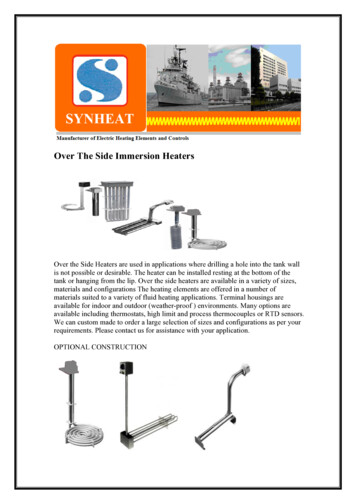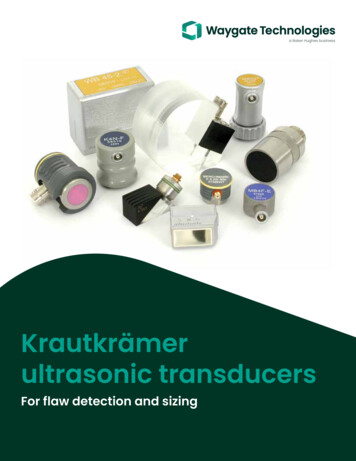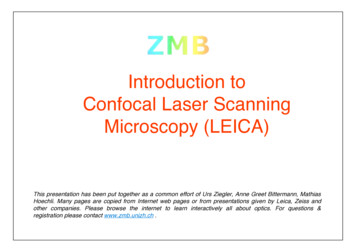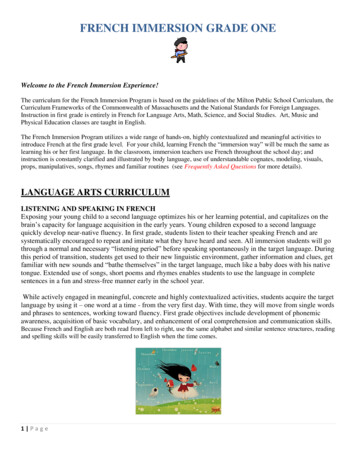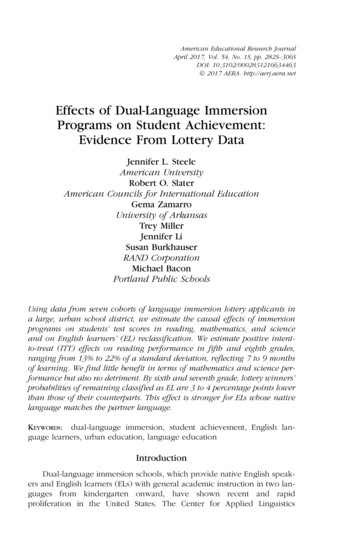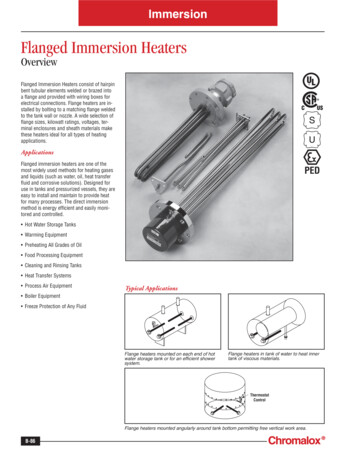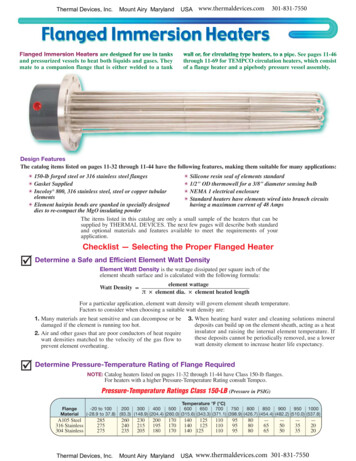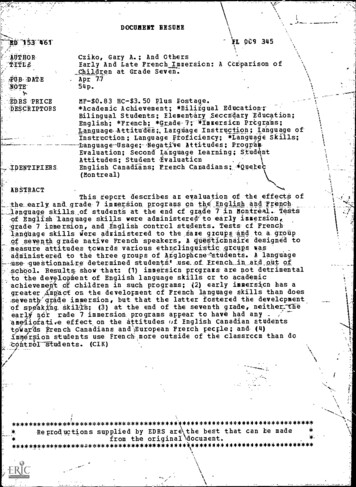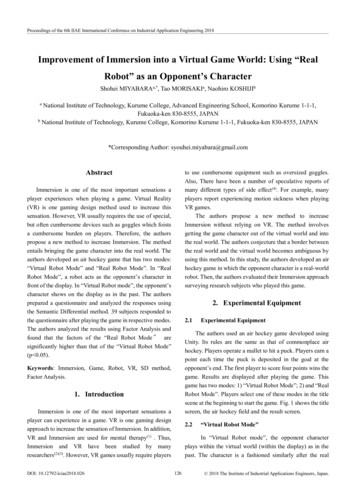
Transcription
Proceedings of the 6th IIAE International Conference on Industrial Application Engineering 2018Improvement of Immersion into a Virtual Game World: Using “RealRobot” as an Opponent’s CharacterShohei MIYABARAa,*, Tao MORISAKIa, Naohiro KOSHIJIbaNational Institute of Technology, Kurume College, Advanced Engineering School, Komorino Kurume 1-1-1,Fukuoka-ken 830-8555, JAPANb National Institute of Technology, Kurume College, Komorino Kurume 1-1-1, Fukuoka-ken 830-8555, JAPAN*Corresponding Author: syouhei.miyabara@gmail.comAbstractto use cumbersome equipment such as oversized goggles.Also, There have been a number of speculative reports ofmany different types of side effect(4). For example, manyplayers report experiencing motion sickness when playingVR games.The authors propose a new method to increaseImmersion without relying on VR. The method involvesgetting the game character out of the virtual world and intothe real world. The authors conjecture that a border betweenthe real world and the virtual world becomes ambiguous byusing this method. In this study, the authors developed an airhockey game in which the opponent character is a real-worldrobot. Then, the authors evaluated their Immersion approachsurveying research subjects who played this game.Immersion is one of the most important sensations aplayer experiences when playing a game. Virtual Reality(VR) is one gaming design method used to increase thissensation. However, VR usually requires the use of special,but often cumbersome devices such as goggles which foistsa cumbersome burden on players. Therefore, the authorspropose a new method to increase Immersion. The methodentails bringing the game character into the real world. Theauthors developed an air hockey game that has two modes:“Virtual Robot Mode” and “Real Robot Mode”. In “RealRobot Mode”, a robot acts as the opponent’s character infront of the display. In “Virtual Robot mode”, the opponent’scharacter shows on the display as in the past. The authorsprepared a questionnaire and analyzed the responses usingthe Semantic Differential method. 39 subjects responded tothe questionnaire after playing the game in respective modes.The authors analyzed the results using Factor Analysis andfound that the factors of the “Real Robot Mode ” aresignificantly higher than that of the “Virtual Robot Mode”(p 0.05).2. Experimental Equipment2.1The authors used an air hockey game developed usingUnity. Its rules are the same as that of commonplace airhockey. Players operate a mallet to hit a puck. Players earn apoint each time the puck is deposited in the goal at theopponent’s end. The first player to score four points wins thegame. Results are displayed after playing the game. Thisgame has two modes: 1) “Virtual Robot Mode”; 2) and “RealRobot Mode”. Players select one of these modes in the titlescene at the beginning to start the game. Fig. 1 shows the titlescreen, the air hockey field and the result screen.Keywords: Immersion, Game, Robot, VR, SD method,Factor Analysis.1. IntroductionImmersion is one of the most important sensations aplayer can experience in a game. VR is one gaming designapproach to increase the sensation of Immersion. In addition,VR and Immersion are used for mental therapy(1) . Thus,Immersion and VR have been studied by manyresearchers(2)(3). However, VR games usually require playersDOI: 10.12792/iciae2018.026Experimental Equipment2.2“Virtual Robot Mode”In “Virtual Robot mode”, the opponent characterplays within the virtual world (within the display) as in thepast. The character is a fashioned similarly after the real126 2018 The Institute of Industrial Applications Engineers, Japan.
(b) The air hockey field(a) The title screen(d) The result screen in when player win(c) The result screen in when player loseFig. 1 The title screen, the air hockey field and the result screen in the gamerobot in “Real Robot Mode”. The character operates a malletby using its own arms in the display. Fig. 2 shows the“Virtual Robot Mode” character in play.The game calculates the path of the puck by addingthe movement distance per frame to the current malletposition. The game moves the opponent’s mallet and character close to the puck.The character can say four different types of messages(through the computer speaker) depending on the gamesituation: 1) “Makenaizo!” (Never give up!) when theopponent gets a point; 2) “Yattazo!” (I did it!) when thecharacter gets a point; 3) “Makechatta ” (I lost ) whenthe character loses; and 4) “Kattazo .” (I won!) when thecharacter wins.2.3This robot was made using Raspberry Pi3, actuators,a speaker, and plastic arms. The robot plays the game byactually using its arms via AirBar. AirBar is a tool thatchanges a normal display to a touch display. The gamecalculates a path of the puck by using the same method thatis used in “Virtual Robot Mode”. The game sends data of thedistance between the touch position and the mallet path to“Real Robot Mode”In “Real Robot Mode”, the opponent characterappears as a real robot in front of the display. There is nodifference between “Virtual Robot mode” and “Real RobotMode” other than real representation of the opponentcharacter. Fig. 3 shows the “Real Robot Mode” robot in play.Fig. 2 The “Virtual Robot Mode” character in play127
the Raspberry Pi3 via Wi-Fi. The robot moves to approachthe puck path.The robot speaks in the same voice as that used in“Real Robot Mode” through a speaker implemented in therobot. The situations when the robot speaks are the same asthose when the virtual characters speak in “Virtual RobotMode”.3. Experiment3.1Experimental MethodThe authors compared game users’ impressionsrelating to Immersion that players got from playing in“Virtual Robot Mode” and in “Real Robot Mode”.The authors prepared a questionnaire using theFig. 3 The “Real Robot Mode” robot in playTable 1 Pairs of polar adjectives and their relation to ImmersionImmersion levelsImpressionsPreferenceEngagementEasy of useRewardsVisualEngrossmentWant to continueIntentionEmpathyTotal ImmersionAtmosphere―NoveltyNo.Positive AdjectivesNegative favorite嫌いなdislikable2親しみやすい friendly親しみにくい �やすい easy分かりにくい �虚なemptiness10達成感のある satisfying達成感のない unsatisfying11手応えのある ��い restless15続けたいwant to continue やめたいwant to �苦しいserious20近づきやすい approachable近づきがたい りそうなcommondecent128rude
Semantic Differential method. Kanda also used SD methodto evaluate an interaction between humans and anautonomous robot(5). The questionnaire has 26 evaluationitems that each consist of a pair of polar adjectives.Respondents evaluated game impressions according to theseevaluation items in 7 levels. The authors determinedadjectives related to immersion with reference to EmilyBrown’s and Paul Cairns’ study(6). Immersion is divided into3 levels. The first level is Engagement. The second level isEngrossment. The third level is Total Immersion. Theauthors have considered the possibility that the “novelty” ofthe game affects the results and, thus, added the polar pairingof “novel-common” to list of adjective evaluation items.Table 1 presents these adjectives and their relation toImmersion. The subjects were all Japanese speakers so thesurvey was conducted in Japanese. However, the authorshave translated the adjectives from Japanese into English forthe purpose of this paper. Therefore, the adjectives may havedifferent nuances between Japanese and English.Subjects of this experiment were 39 students from theNational Institute of Technology, Kurume College (NITKC).Subjects played the game and responded to the questionnaireafter playing the game in respective modes.3.2Result and EvaluationThe authors assayed the results of the experiment usingthe Wilcoxon signed rank test. The analysis revealed that theresults of “Real Robot Mode” were significantly higher thanthat of “Virtual Robot Mode” (p 0.05).Fig. 4 presents the average of results for each adjective.The authors predicted that these adjectives would havestepwise differences among the Immersion levels. However,the analysis showed that this was not the case. The authorsconjecture that the reason for a lack of stepwise differencesmay be because of a mis-selection of the polar adjectives.Therefore, the authors analyzed the results using FactorAnalysis and classified the factors into the immersion levels.Using Factor Analysis to better understand the results ofthe experiment, the authors removed adjectives withcommunalities less than 0.3. This criteria removed four polaradjective pairs: “early-late”, ”quick-slow”, and ”gorgeousplain”. The authors determined a number of factors to 8 byusing eigenvalues and assayed that the number is adequateusing the Chi-squared test. The cumulative contribution ratioof these factors is 70.4%. Table 2 presents loadings andproportions of variance and communalities after varimaxrotation. The authors regarded loadings greater than 0.5 ashigh loadings. The high loadings are shown in bold in Table2.The authors calculated the factor scores and comparedthem between “Virtual Robot Mode” and “Real RobotMode”. The authors assayed the averages of the factor scoresusing Wilcoxon signed rank test. The authors found that thefactor scores of “Real Robot Mode” are significantly higherthan those of “Virtual Robot Mode” (p 0.05). Fig. 5 presentsa comparison of the factor scores between “Virtual RobotMode” and “Real Robot Mode”. This means the “Real RobotMode” has the effect of giving the player a better impressionthan the “Virtual Robot Mode”.The authors considered respective factors and classifiedthese into the immersion levels. Factor1 has high loadings inthe adjectives of “Preference”, “Empathy” and“Atmosphere”. The reason for this may be because of a misselection of adjectives in Total Immersion. For example,“casual-serious” are similar to the adjective “Preference”.Therefore, Factor1 may relate to “Preference” inFig. 4 The average of results for each adjective129
Table 2 LoadingsNo Positive adjectives Factor1 Factor2 Factor3 Factor4 Factor5 Factor6 Factor7 Factor8 070.1490.391-0.0080.0500.0560.1900.58010 .1170.59311 99512 6213 9514 .67915 want to 0.99516 770.66317 .45918 019 67020 0440.78122 0.56123 024 5 70.48526 14.03111.2218.1737.5125.0044.3702.473variance explainedpropotion of varianceEngagement. Factor2 has high loadings in the adjectives“Preference” and “Rewards”. Therefore, Factor2 may relateto “Preference” and “Rewards” in Engagement. Factor3 hashigh loadings in the adjective “Visual”. Therefore, Factor3may relate to “Visual” in Engrossment. Factor4 has highloadings in the adjective “Want to continue”. Therefore,Factor4 relates to “Want to continue” in Engrossment.Factor5 has high loadings in the adjective “Easy of use” inengagement. Therefore, Factor5 may relate to “Easy of use”in Engagement. Factor6 has a high loading in only “wisefoolish”. The authors consider that a number of high loadingsis not enough to conjecture a relationship betweenImmersion and Factor6. Therefore, Factor6 may not relate toImmersion. Factor7 has a high loading in only “novelcommon”. Therefore, Factor7 may relate to “Novelty”. Thisadjective is added by the authors to study an influence of“Novelty”. An influence of Factor7 is low except for“Novelty”. Therefore, the authors conjecture that “Novelty”doesn’t affect the result of the experiment. Factor8 has nohigh loadings. However, Factor8 has relatively high positiveFig. 5 Comparison factor scores130
the results of the “Real Robot Mode” are significantly higherthan the results of “Virtual Robot Mode” (p 0.05).Fourth, the authors used factor analysis to betterunderstand the results of the experiment. As a result, 8factors were found.Fifthly, the authors assayed the averages of the factorscores using Wilcoxon signed rank test. The authors foundthat the factor scores of “Real Robot Mode” are significantlyhigher than those of “Virtual Robot Mode” (p 0.05).Sixthly, the authors classified respective factors into theimmersion level. Table 3 presents the classification of thefactors.Seventhly, the authors assayed the averages of the factorscores related to Immersion using the Wilcoxon signed ranktest. The authors found that the factor scores of “Real RobotMode” are significantly higher than those of “Virtual RobotMode” (p 0.05).However, there are three problems. Firstly, the authorsonly found one factor of Total Immersion. The authorsconjecture that the reason is a mis-selection of adjectives inTotal Immersion. The authors have to change the adjectivesto find factors related to Total Immersion.Secondly, the factor of Total Immersion doesn’t havehigh loadings. Therefore, the authors conjecture that thesubjects couldn’t immerse in the game until Total Immersion.Players may have to play the game for a long time in orderto immerse until Total Immersion. Moreover, players mayhave to like the game in order to immerse until TotalImmersion. The authors have to develop an enjoyable game.Moreover, the subjects have to play for a longer duration.Thirdly, because the number of subjects was too few, theresults couldn’t be analyzed using factor analyses. Moreover,the subjects belonged to the same group. Therefore, the resultof factor analysis may be not accurate. The authors have tonot only increase the number of subjects, but select a morediverse group of subjects.Therefore, the authors will experiment again afterresolving these problems.Table 3 The classification of the factors.Immersion tal ImmersionFactorsFactor1Factor2Easy of useFactor5RewardsFactor2VisualFactor3Want to continue Factor4EmpathyFactor8loadings in “warm-cold” and has relatively high negativeloadings in “pretty-detestable”. Factor8 may relate to theopponent character since about 60% of the subjects lost whenplaying the game. When players are immersed in a game andlose, they feel frustrated against their opponent. Thefrustration doesn’t detract from the warmth of the game. Theauthors conjecture that the player's impression of theopponent relates to the feeling of “Empathy”. Therefore,Factor8 may relate to “Empathy” in Total Immersion.The authors assayed the averages of the factor scoresrelated to Immersion by using the Wilcoxon signed rank test.The authors found that the factor scores of “Real RobotMode” are significantly higher than those of “Virtual RobotMode” (p 0.05). Therefore, the authors conjecture thatplayers get more of a feeling of Immersion in “Real RobotMode” more than in “Virtual Robot Mode”.4. ConclusionsIn this study, the authors attempt to improve the sensationof Immersion in games by placing the virtual game opponentcharacter in the real world as a robot.Firstly, the authors developed an air hockey game whichhas two modes: “Virtual Robot Mode” and “Real RobotMode”. In “Virtual Robot Mode”, the opponent characterexists within the screen; Whereas in “Real Robot Mode”, theopponent character exist “in front” of the display in the realworld as a robot.Secondly, the authors experimented with 39 adjectivesusing the SD method. Subjects played the game andresponded to a questionnaire after playing the game inrespective modes. The questionnaire has 26 evaluation itemsthat consist of 2 polar adjectives related to Immersion. Table1 presents these adjectives.Thirdly, the authors assayed the results of the experimentusing the Wilcoxon signed rank test. The authors found thatAcknowledgmentThe authors are grateful to 39 students of NITKC whocooperated the experiment in this paper.131
References(1) M. Krijn, P.M.G. Emmelkamp, R.P. Olafsson and R.Biemond : “Virtual reality exposure therapy ofanxietydisorders: A review”, Clinical Psychology Review, Vol.24 , pp. 259-281, 2004(2) Randy Pausch, Dennis Proffitt and George Williams :“Quantifying Immersion in Virtual Reality”,SIGGRAPH, Vol. 24, pp. 13-18, 1997(3) George Robertson, Mary Czeminski, and Maarten vanDantzich : “Immersion in Desktop Virtual Reality”,UIST, Vol. 10, pp. 11-19, 1997(4) John R. Wilson, “EFFECTS OF PARTICIPATING INVIRTUAL ENVIRONMENTSA REVIEW OFCURRENT KNOWLEDGE”, Safety Science, Vol. 23,No. 1, pp. 39-51, 1996(5) Takayuki Kanda, Hiroshi Ishiguro, Tetsuo Ono, MichitaImai and Ryohei Nakatsu : “An evaluation on interactionbetween humans and an autonomous robot Robovie”,The Robotics Society of Japan, Vol. 20, No. 3, pp. 315323, 2002(6) Emily Brown and Paul Cairns : “A GroundedInvestigation of Game Immersion”, CHI EA, Vol. 4, pp.1297-1300, 2004132
robot in "Real Robot Mode". The character operates a mallet by using its own arms in the display. Fig. 2 shows the "Virtual Robot Mode" character in play.
